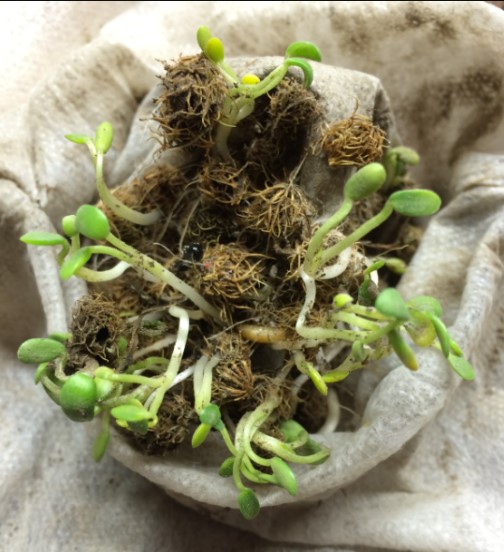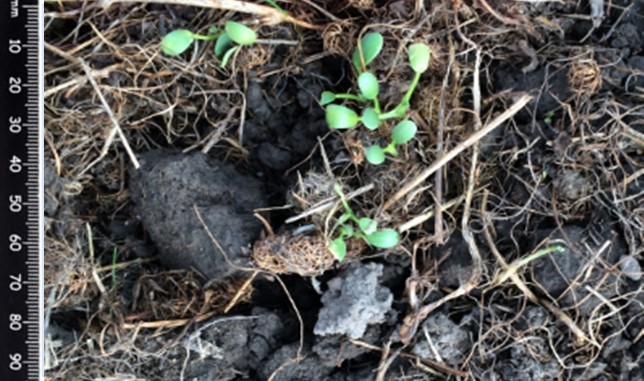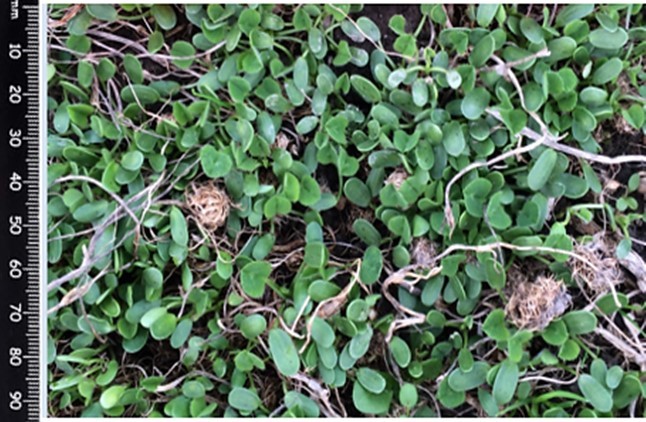Posted on behalf of Carmen Teixeira (PhD candidate with the Dryland Pasture Research Team)
The longevity of sub clover in the swards is largely controlled by seed hardness.
Seed hardness is common in legumes such as sub clover. It is a strategy to prevent germination during unsuitable ecological conditions, mainly when the probability of seedling survival would be low. The delayed seed germination allows time for dispersal and prevents germination of all the seeds at the same time. It also safeguards some seeds and seedlings from suffering damage or death from short periods of bad weather or from grazing. In addition, hardseededness allows some seeds to germinate when competition from other plants for light and water might be less intense.
Figure 1. A 10 cm x 10 cm quadrat with sub clover seedlings. Note: very large cotyledons. This photo shows a high density seedling population. Field Research Centre, Iversen 2 experiments. Photo: Carmen Teixeira, Lincoln University.
For sub clover the hard seed coat prevents the germination even when environmental conditions, like moisture and temperature, are ideal. For sub clover, these optimum conditions for germination and seedling emergence are happening now in autumn.
Figure 2. Seedling emergence from last year burrs. Evaluations of seed germination and emergence rates in field experiments at Iversen 2, Field Research Centre. 02 March 2017. Photo: Carmen Teixeira, Lincoln University.
Cultivars are normally ranked according to the hardseededness levels. For instance, ‘Woogenellup’ is known for a low level of hard seeds (Score 1) compared to ‘Rosabrook’, with medium/high levels of hard seeds (Score 5). This ranking system was created in Australia. It is important to know that for the Aussie environment (particularly Western Australia) the long dry hot summers make hard seed in annuals a desirable characteristic. The more “hard” the cultivar the longer it takes for seeds to germinate. Check the sub clover guide for more information about the hardseededness levels for each cultivar.
The mechanisms that control the degree of hardness in the sub clover seed coat are currently not completely known. Our Dryland Pastures Research Team, in collaboration with the Bionami group at Boku (Vienna, Austria), aims to reveal the possible reasons for the impermeable seed coat of the subs.
From macro to micro
Using modern techniques, we want to unveil the chemical components of the sub clover seed coat and identify key compounds responsible for differences in seed hardness of contrasting sub clover cultivars.
Figure 3. Seeds and the seed coat of ‘Monti’. Detail of a seed section showing the waterproof tissues which prevent water uptake (macro and micro view). Seeds produced at Field Research Centre (Lincoln University) and microscopic images at Bionami (Imaging Centre, Boku University) 22 March 2017. Photos: David Hollander and Carmen Teixeira, Lincoln University.
From the lab back to the field
Look at the following pictures taken in autumn 2016… guess which image shows a high level of hard seeds?
That’s right! The photo at the top is an example of a “high level” of hard seeds and therefore low emergence. In the photo below it has few hard seeds and therefore many emerged seedlings. Photos: Carmen Teixeira, Lincoln University.
Today it is unclear how the new released cultivars introduced into New Zealand, and ranked for seedhardness in Australia, respond to the New Zealand climate particularly under the temperate Canterbury conditions. Our efforts to unveil the mysteries of the seed coat will help to determine the best cultivars for our environment and guide future sub clover selection. Meanwhile, it makes sense to use a mix of complementary cultivars to increase resilience and the success of sub clover dominant swards.




